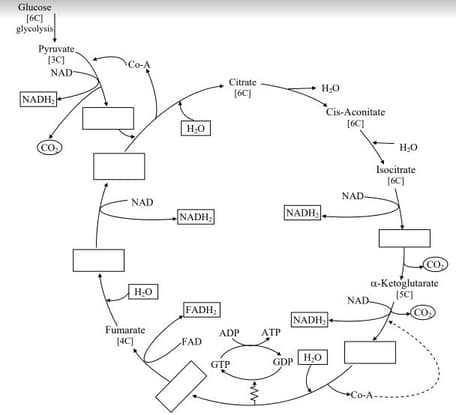MEDIUM
Earn 100
Kreb's cycle is the major source of ATP production in the cells.
(a)True
(b)False
50% studentsanswered this correctly
Important Questions on Metabolism, Cell Respiration and Photosynthesis (AHL)
EASY
A) Reaction of pyruvic acid with OAA and form citric acid
B) Formation of two molecules
C) Release of molecules
D) Formation of one GTP molecule
MEDIUM
| Column -I | Column -II | ||
| Mitochondrial matrix | p | Krebs' cycle | |
| Cytoplasm | q | ETC | |
| and | r | Glycolysis | |
| Inner mitochondrial membrane | s | ATP synthesis |
EASY
A) Lactate dehydrogenase
B) Succinate dehydrogenase
C) Acetyl CoA
D) Alcohol dehydrogenase
HARD
Write down the names of missing intermediate compounds in a sequence in the given diagrammatic representation of Kreb’s cycle.
EASY
EASY
A) Triose bis Phosphate to triose phosphate
B) Phosphoglycerate to Phosphoenol pyruvate
C) Succinyl CoA to Succinic acid
D) Malic acid to
MEDIUM
HARD
EASY
In the following reaction, identify and respectively:
HARD
Match the metabolic pathways in Column I with their corresponding intermediate molecules listed in Column II
| Column I | Column II | ||
| P | Krebs cycle | i | Dihydroxyacetone phosphate |
| Q | Glycolysis | ii | Succinate |
| R | Electron transport chain | iii | Cytochrome |
| S | Nitrogen fixation | iv | Glutamate |
| v | Glyoxylate | ||
Choose the CORRECT combination.
EASY
HARD
Identify the reactions where energy is produced:
I.
II.
III.
IV.
V.
The correct combination is:
MEDIUM
HARD
(A) OAA+ Acetyl CoA → Citric acid + CoA
(B) Fumaric acid + H2O → Malic acid
(C) Cis-aconitic acid → Isocitric acid
(D) Succinyl CoA + ADP + Pi → Succinic acid + ATP +CoA
HARD
HARD
HARD
EASY
MEDIUM
MEDIUM


